Day of the complete liberation of Leningrad from the fascist blockade
14 January The 1944 of the year began the Krasnoselsko-Ropshinskaya operation (the “January Thunder”) of the troops of the Leningrad Front against the 18 of the German army besieging Leningrad. This operation was part of the Leningrad-Novgorod strategic operation. As a result of the January 27 blockade of Leningrad, the 872 of the day was over.
General situation
September 8 The Germans, with the support of the Finnish army, closed the ring around Leningrad, the second most important strategic, political, economic and cultural center of the country. 1941 January 18, the blockade was broken, and the city appeared a corridor of land communication with the country. After breaking through the enemy blockade of Leningrad in January 1943, the situation in the besieged city improved in many ways. The resumption of land communication with the mainland has increased the standards of food supply. They began to meet the standards established for other major industrial centers. Significantly changed the situation with the fuel.
However, the Soviet troops failed to completely free the city from the siege. The troops of the German 18th Army were in the immediate vicinity of Leningrad and continued intensive artillery shelling of the city and the railway "Victory Road". Leningrad continued to live in front-line conditions. The Germans fired on the city. In September, for example, 5 thousand shells fell on him. German aviation in March - May 69 times bombed the city. True, already in the fall of 1943 in the north-west direction as a result of an increase in the number and more coordinated actions of fighter aircraft of the fronts, the Leningrad air defense army and Baltic air defense systems fleet air conditions have improved. Soviet aviation gained air supremacy, which led to a sharp decrease in the intensity of enemy attacks on troops and directly on Leningrad. On the night of October 17, the last bomb fell on the city.
Despite the continuing difficult combat conditions and lack of manpower, Leningrad industry increased its military output. Thus, the production of large-scale naval artillery was resumed in the city. From the third quarter began the mass release of artillery shells and mines for all types of mortars. The construction of small ships and boats, first of all the minesweepers essential to the fleet, was launched. At the same time, there was a tough saving of raw materials, fuel and electricity. Part of the work was restored 85 large industrial enterprises. By the end of the year, 186 of such enterprises operated in the besieged city.
I. Fedyuninsky assessed the situation near Leningrad by the end of 1943: “The situation near Leningrad was determined by the general situation on the fronts. During 1943, the Soviet Army delivered a series of heavy blows to the German fascist troops and forced the enemy to retreat continuously. By November, the enemy was forced to clear almost two-thirds of the territory of our Motherland he had captured. But near Leningrad, the Nazis, having girded themselves with a powerful defensive line, continued to improve their positions and hoped to keep them as the basis of the entire left wing of the Eastern Front. ”
As a result, the task of ensuring the security of Leningrad, as well as military-strategic considerations related to the further conduct of the war, the development of an offensive on the northern flank of the Soviet-German front, demanded a complete lifting of the blockade and the liberation of the Leningrad Region. Its implementation opened the way to the Baltic, facilitated the liberation of Karelia and the defeat of Finland, the exit of the fleet to the expanses of the Baltic.
The forces of the parties
The German Army Group Sever (18th and 16th Army), commanded by Field Marshal G. Küchler, numbered 741 thousand soldiers and officers, 10 guns and mortars, 070 tanks and assault guns, 370 aircraft. For two and a half years, the enemy created strong defensive positions with reinforced concrete field fortifications, numerous bunkers, a system of wire barriers and minefields. All settlements in the defense zones were turned by the Germans into nodes of resistance and strongholds. Particularly powerful fortifications were located in the area south of Pulkovo heights and north of Novgorod. The Nazis were confident in the invincibility of their "Northern Wall".
The German Army Group North was opposed by the troops of the Leningrad Army (without the 23 Army), the Volkhov and the 2 Baltic Front, which consisted of 1252 thousand soldiers and officers, 20183 guns and mortars, 1580 tanks and self-propelled guns, 1386 combat aircraft.
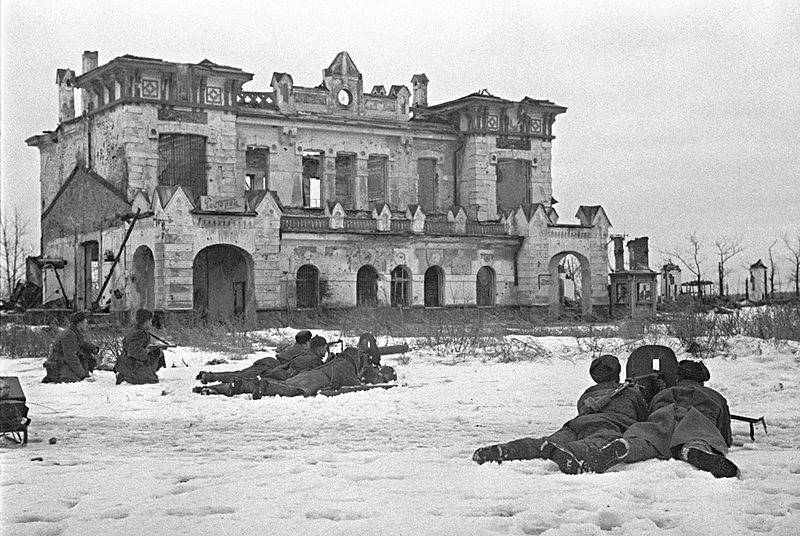
Soviet soldiers are machine-gunning the enemy near the old station building of the station Detskoe Selo near Leningrad. Pushkin, Leningrad Region
Plans of the parties. Preparation of the operation
In early September, 1943, the Soviet command became aware that German troops began preparing a retreat from Leningrad to new defensive lines on the Narva River - Lake Peipsi - Pskov - Island - Idritsa (Panther Line). Based on the current situation, the military councils of the Leningrad and Volkhov fronts immediately began to develop a plan for a joint large-scale operation in order to defeat the 18 of the German army and completely liberate Leningrad from the blockade. Since until the end of 1943, uncertainty about the plans of the German troops remained, the Soviet command developed two options for the offensive. The first option provided for an immediate transition to pursuing the enemy in the event of his retreat (“Neva 1”), and the second - a breakthrough of the enemy's echeloned defense in case the German troops continued to hold their positions (“Neva 2”).
The position of Army Group “The North has deteriorated significantly. The German command could not strengthen it either at the expense of strategic reserves, or at the expense of the transfer of forces from other army groups, as they were constrained by the powerful offensive of the Soviet troops in the south-western and western directions. Throughout the entire 1943 year for Hitler, Army Group North didn’t exist. From July 1943 to January 1944, Kühler had to transfer several of the most combat-ready divisions to Army Groups Center and South. In order to somehow compensate for the withdrawal of troops from the north-western direction, several less combat-ready divisions and brigades were transferred there.
The command of Army Group North had information about the preparation of the Soviet troops for an offensive, which made G. Kühler turn to Hitler with a request to speed up the withdrawal of troops to the Panther line. However, the Fuhrer, focusing on the opinion of the commander of the 18 Army G. Lindeman, who insisted that his troops would repel the new Soviet offensive, ordered Army Group North to continue the siege of Leningrad. The German High Command set the task force of the North Group to firmly defend their positions, to continue the blockade of Leningrad. The stabilization of this sector of the Russian Front allowed reliably cover the approaches to the Baltic States and its naval bases, preserve the freedom of action of the German fleet in the Baltic Sea and ensure maritime communications with Sweden and Finland.
The Soviet Stavka, with some corrections, approved the ideas of the military councils of the fronts on the planned operation. Its overall plan was to defeat the Peterhof-Strelninsky and Novgorod groups of the 18 of the German army by simultaneous strikes by the troops of the Leningrad and Volkhov fronts, and then, developing an attack on the Kingisepp and Luga axes, to complete the defeat of this army. At a later stage, by attacking all three fronts in the directions of Narva, Pskov and Idritsa, it was planned to defeat the German 16 Army and completely liberate the Leningrad and Kalinin Regions. The actions of the ground forces were to support the 13-I, 14-I and 15-I air armies and long-range aviation, as well as artillery and aviation of the Baltic Fleet.
The offensive was prepared with great care. The troops regrouped in the fronts to create shock groups. The 2 shock army commanded by General I. I. Fedyuninsky was covertly transported from Leningrad and Lisiy Nos to the Oranienbaum area by ship. The defenders of this small seaside bridgehead, located west of Leningrad, surrounded by a half-ring of enemy troops, covered Kronstadt from the land, and the Kronstadt fortress supported them with their batteries. Oranienbaum seaside bridgehead was to play an important role in defeating the opposing enemy. From November 1943 to January 1944 was delivered by sea in harsh weather conditions 53 thousand people, 658 guns, a lot of tanks, cars, tractors, tens of thousands of tons of ammunition and other military goods. At the same time, the Germans were misled: until the very last moment, they believed that the Soviet command was sending troops from the bridgehead to the city.
Offensive
14 January 1944, the troops of the Leningrad Front, commanded by General L. A. Govorov, launched an offensive. From the Oranienbaum bridgehead, troops of the 2 Shock Army broke through in the direction of Ropsha. Initially, a powerful blow to the enemy was inflicted by artillery of the army and the Baltic Fleet, bringing down over 100 thousand shells and mines to the position of the Nazis. Then the infantry went on the attack, acting in close cooperation with tanks and artillery. The Nazis stubbornly resisted, every meter of land won back with a fight. The next day the fierce struggle continued. Fedyuninsky's troops repulsed before the 30 counterattack.
Towards them with fierce battles, the 42-I army of General I. I. Maslennikov advanced, striking from the Pulkovo Heights area. On the third day of Operation 2, the Shock Army completed the breakthrough of the enemy’s main defense zone, moving deeper into 8 - 10 km and expanding the breakthrough to 23 km. January 19 was taken Ropsha - a powerful stronghold of enemy defenses. On the same day, the troops moving from the Pulkovo Heights stormed the Red Selo by storm. Here there was a meeting of parts of the 2 th shock and 42 th armies of the Leningrad Front. The Peterhof-Strelnyi grouping of the German 18 Army was defeated.
Thus, in six days of offensive battles, the troops of the Leningrad Front advanced into the depths of the enemy defense by 25 km. The German artillery that shelled Leningrad from the region of Dudergof - Voronya Gora, fell silent forever.
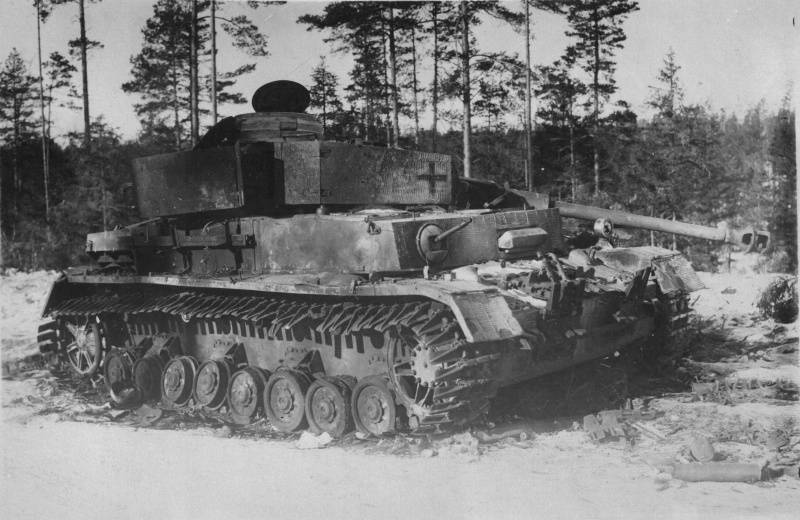
Founded during the operation "January Thunder" German tank PzKpfw IV
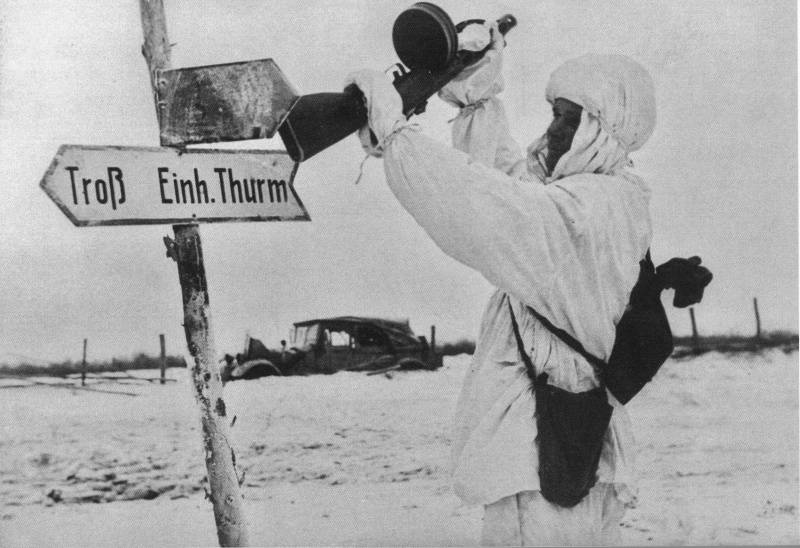
Automator V. Kh. Timchenko knocks down a German traffic sign with the butt of an automatic rifle. The photo was taken during the operation on the final lifting of the blockade of Leningrad.
January 14 launched an offensive and the Volkhov Front commanded by General K. A. Meretskov. The main blow here was struck north of Novgorod in difficult conditions of wooded and marshy terrain by the 59 Army under the command of General I. T. Korovnikov. After an hour and a half of artillery preparation, the breakthrough tanks and infantry moved into enemy positions.
“Bad weather made it difficult for artillery to conduct aimed fire, and because of low cloud cover, aviation was not able to take part in the preparation of the offensive at all and entered into force only on the second day. Some tanks were stuck in the swamp: a sudden thaw, unusual for January, turned the hilly ice fields covered with bushes into a messy mess ”. However, these obstacles did not stop our troops. “Separate regiments of 6 and 14 of rifle corps,” Marshal KA Meretskov recalled, “reached the line of attack a few minutes before the end of the artillery preparation, and when the artillery moved the fire into the depths, these regiments broke into the enemy defenses. The strike was so powerful, sudden and swift that the first position of the Nazi defense immediately passed into our hands, and on January 15 the Novgorod-Chudovo railway was cut. ”
The southern group of troops of this army forced Lake Ilmen across the ice at night and cut the Novgorod-Shimsk railway, which created a threat to enemy communications from the south. The troops of the 59 Army successfully broke through the enemy’s main line of defense north of Novgorod. Field Marshal Kühler removed 24 and 21 divisions from under Mgi and Chudovo, and 290 and 8 divisions from under Solts and Staraya Russa and threw them into the Lyubolyad area to close the gap. However, the Soviet troops continued the offensive.
On the morning of January 20, the northern and southern groups of the attacking forces joined west of Novgorod. On the same day a decisive assault on the ancient Russian city was cleared of the Nazis. “I came to Novgorod as soon as he was released,” KA Meretskov recalled. “Dead silence reigned in the streets. For the whole city remained about forty buildings. The greatest monuments of antiquity, the pride and decoration of old Russian architecture, were blown up. ” At the same time, the 8-I and 54-I armies of the Volkhov Front actively hampered the enemy forces in the Tosno, Luban and Chudov directions, preventing the German command from transferring troops from there to Novgorod.
The German command, seeing the threat of the entourage of the 18 Army, removed its units and units from the bulge east of Tosno, Chudovo. The offensive deployed across the front from the Gulf of Finland to Lake Ilmen. The troops of the Leningrad Front liberated Pushkin, Pavlovsk, Gatchina and by the end of January reached the line of the Luga River. The Volkhov Front, advancing in the direction of Luga and Shimsk, liberated the cities and railway stations of Mga, Tosno, Lyuban, and Chudovo. The October Railway was cleared from the Germans. At the same time, the 2 Baltic Front, under the command of General MM Popov, fettered the German 16 Army.
Thus, the Red Army crushed the "Northern Wall" and completely eliminated the enemy blockade of Leningrad. On January 27 in the evening in the city on the Neva, a ceremonial artillery salute of 324 guns thundered. Historical victory along with Leningraders joyfully celebrated the entire Soviet people.
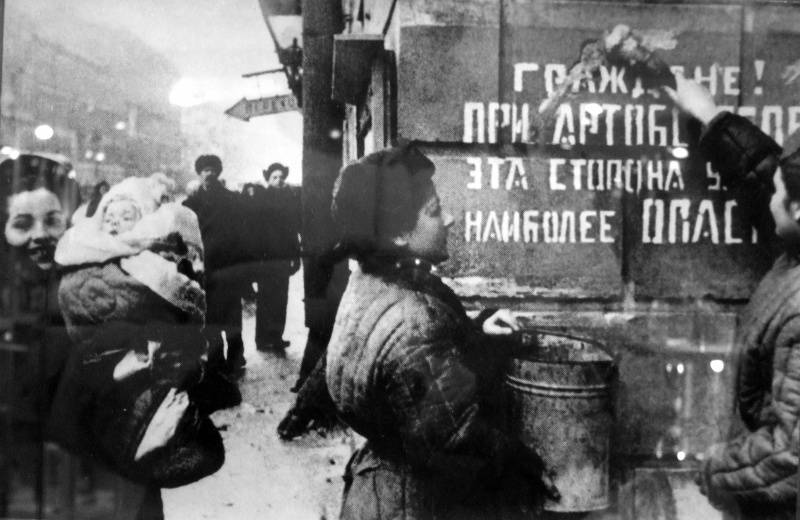
Leningradians paint over the inscription on the wall of the house, warning about the shelling, after the final liberation of the city from the enemy blockade. The inscriptions "Citizens! During shelling, this side of the street was the most dangerous "was inflicted in Leningrad on the north and north-east sides of the streets, as the shelling was fired from the south (Pulkovo heights) and south-west (Strelna) directions.
The Nazi headquarters, as usual with a heavy defeat at the front, hid its real reasons. But Field Army Marshal Kühler, commander of Army Group North, was replaced by Colonel-General V. Model, who enjoyed the reputation of a "strategic defense specialist."
Soviet troops continued to develop the offensive. 2-I shock army of the Leningrad front 1 February forced Luga and stormed Kingisepp. The 42 Army I, advancing to the south, 4 February entered the Gdov liberated by partisans. The Volkhov Front, defeating the enemy's Luga grouping, February 12 captured Luga. Soon after, he was disbanded, and his armies were transferred to the Leningrad Front. The upcoming connections reached the line of the Narva River. 18-I German army retreated. The 16 Army was also withdrawing. In pursuit of it, the troops of 2 of the Baltic Front 18 of February liberated Old Russa, and then the city of Hill.
On the right wing of the Leningrad Front, troops entered the territory of Soviet Estonia, and on the left flank, in cooperation with the 2 Baltic Front, occupied an important railway junction - the Dno station. By the end of February, the advancing Soviet troops stopped at the turn of Narva - Pskov - Ostrov, where they occupied the defense. It was necessary to regroup, replenish the troops, equipment and ammunition, tighten the rear.
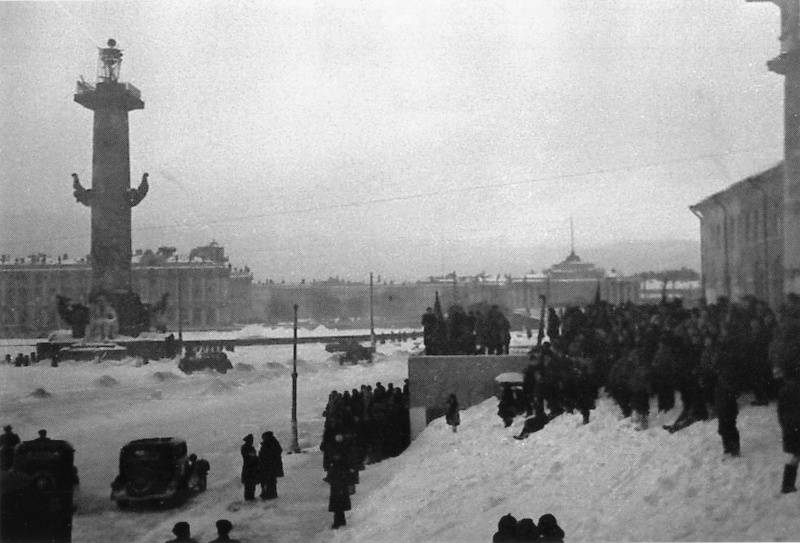
Residents of Leningrad at the stock exchange building meet the news of the lifting of the blockade of the city
Results
As a result of a one-and-a-half-month continuous offensive in the north-western direction, the Red Army inflicted a heavy defeat on Army Group North and threw it to 220 - 280 km to the west. 3 German divisions were destroyed and 17 divisions were defeated. Almost the entire territory of the Leningrad and Kalinin regions was liberated from the German invaders. In the course of the offensive operation near Leningrad and Novgorod, the southern and south-eastern approaches to Leningrad were cleared of Germans. Only at the northern outskirts of this city were still Finnish troops who participated in its blockade. It was necessary to carry out their rout on the Karelian Isthmus and in South Karelia.
The great battle for Leningrad, one of the most significant and bloody battles of the Great War, which lasted 900 days, ended with the victory of the Red Army and the entire Soviet people. Despite the harsh ordeals and tremendous sacrifices, the hero-city survived a fierce fight.
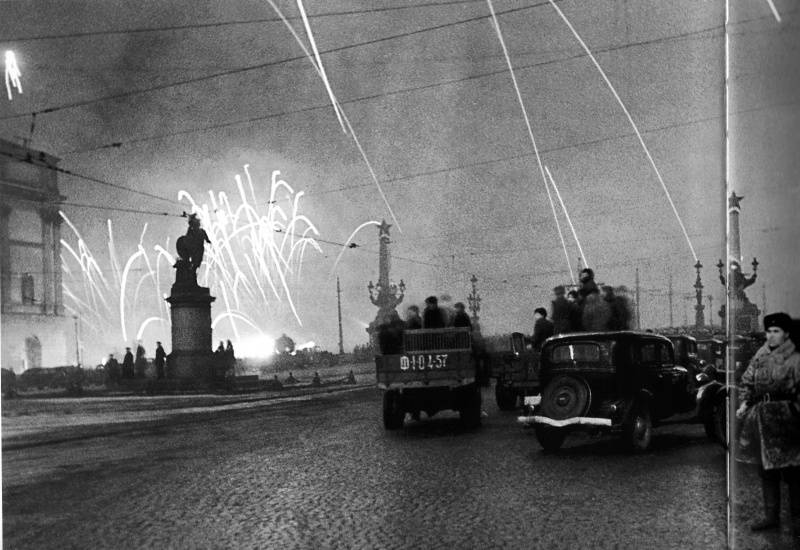
Leningraders of Suvorov Square watch fireworks to mark the lifting of the blockade
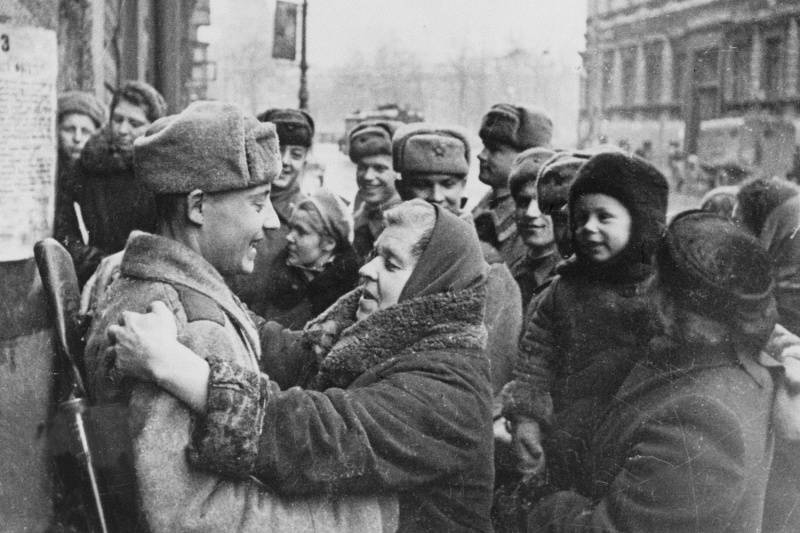
Leningradians and Red Army soldiers ordered the troops of the Leningrad Front to lift the blockade of the city. Photo source: http://waralbum.ru/
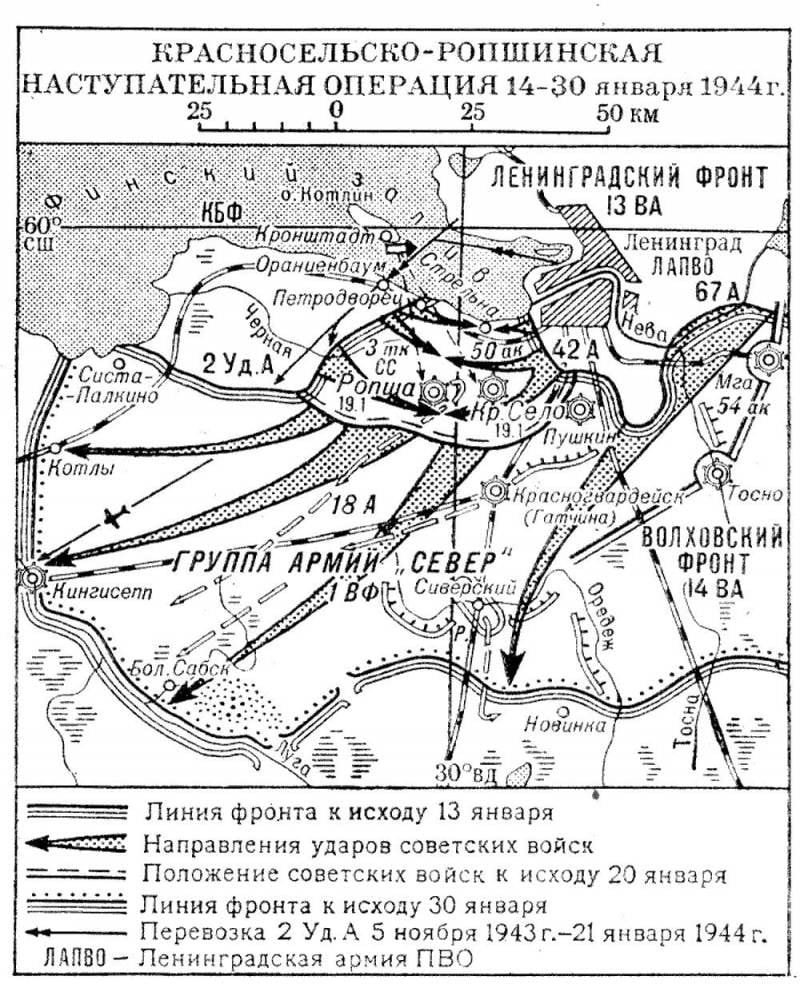
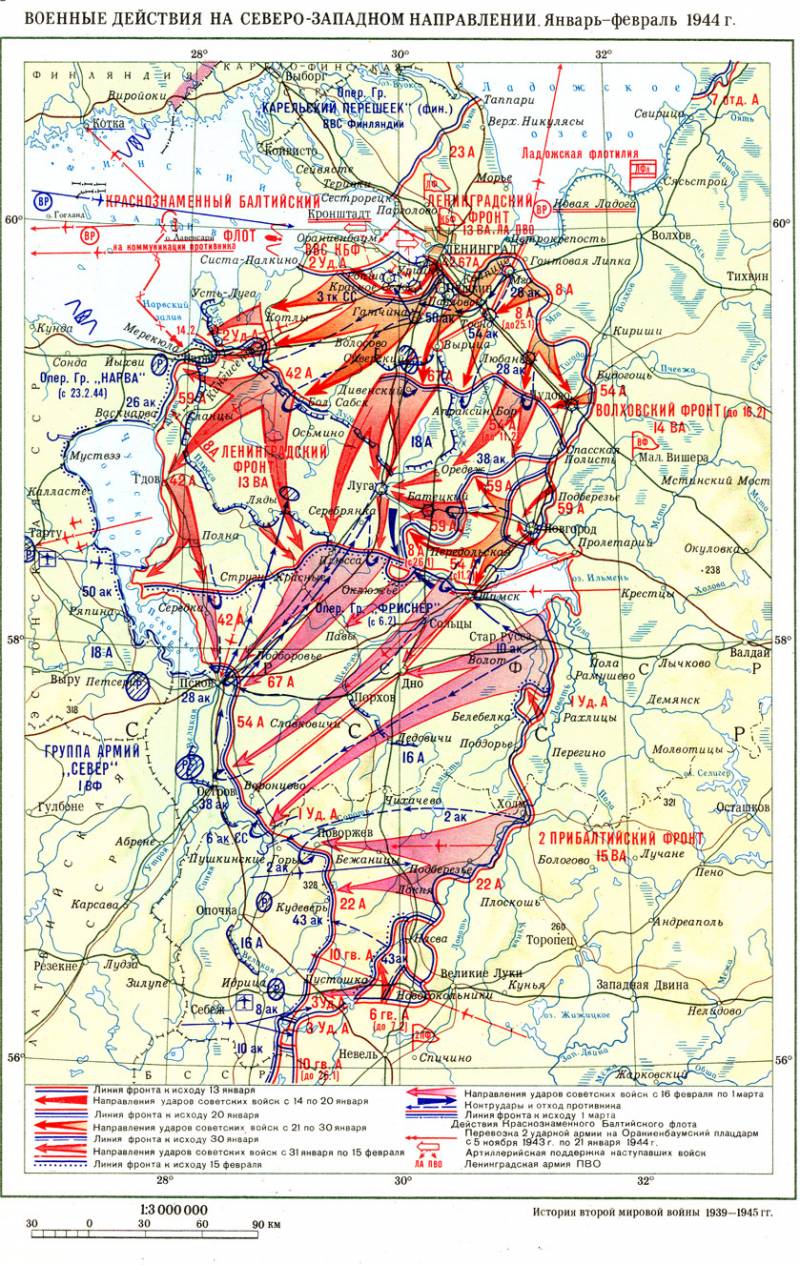
Information